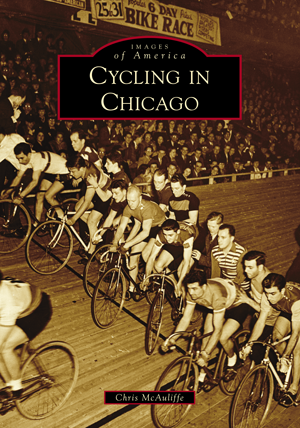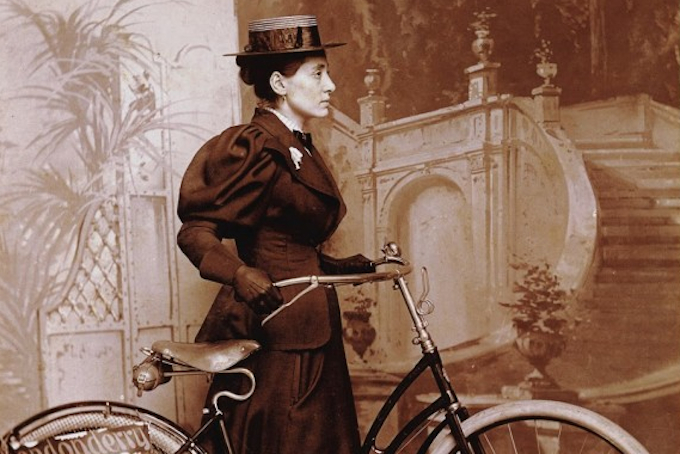Chris McAuliffe's “Cycling in Chicago” (2018, Arcadia Publishing) is a brief yet fascinating overview of the rise, fall and rebirth of bicycling in Chicago and environs. It's just long enough to cover the basic timeline of the city's growth as a bike manufacturing powerhouse and center for road and track racing; the Schwinn company; early cycling infrastructure; and Chicago's currently lauded status as a center of cycling for recreation AND transportation. But what makes the book fun to flip through, like other titles in Arcadia's hyper-local "Images of America" series, is the inclusion of plenty of great historic photos. The dozens of pics in this slim volume come largely from the author's own collection, as well the Oscar Wastyn family archives of Chicago bicycling history. (The family owns Wastyn Cycles, the city's oldest bike shop, located at 2634 W. Fullerton in Logan Square.)
Though many longtime Chicagoans and local cyclists know of the Schwinn company's history here, there's less awareness that the company was once only one bicycle manufacturing firm among many. For a time in the late 1800s, Chicago was the largest hub of bike and component fabricators in the country, with 90 companies. By 1889, fully two-thirds of the country's bicycles were made within 150 miles of Chicago. McAuliffe writes that at that time Chicago was “the Detroit of bicycle manufacturers.”
In the late 19th century bicycles were expensive, so cycling was primarily a pastime or sport for affluent folks. But demand eventually led to mass production, which made bikes affordable to the masses. McAuliffe tracks the rise of cycling clubs around the city during this manufacturing boom, some of them boasting several hundred members, with their own brick-and-mortar clubhouses. One wonders what functions these clubhouses served. Were they meeting points for group rides? A place to sit and discuss the highlights afterward? A location to chat over cocktails about the finer points of the new “balloon” tires that would eventually replace wooden wheels, greatly increasing speed and comfort?

The book's second and third chapters cover the peak of biking as a form of recreation and a sport in the 1920s and 1930s. McAuliffe includes some fascinating photo from this period, such as images of the long-distance “bike train” rides organized by the League of American Bicyclists, which helped riders escape the dirt and crowds of the city out into the region's hinterlands (now suburbs.) By the 1920s, indoor velodromes such as the Chicago Coliseum and Chicago Stadium began springing up around town, hosting many “6-Day Races,” in which teammates would switch off, riding several hours per day. There's an entire chapter devoted to the many venues that hosted these events, most of which are long gone. There's even an article detailing the riders' typical diet regimens during the races.
Outdoor road and cyclocross (bicycle steeplechase) races in the 1930s and 1940s were large events often held in local parks such as Humboldt Park and many outdoor velodromes. These are also documented in dozens in pictures that help illustrate what an exciting period this must have for competitors and fans.
A later chapter highlights several of the colorful personalities and key leaders who helped shape Chicago cycling, including advocating for better cycling conditions. These include pioneering round-the-world cyclist Annie Londonderry, racing legend Marshall “Major” Taylor, the Schwinn and Wastyn families, and Mayor Richard M. Daley, among others.
I was a little disappointed that the book devotes more space for the transportation cycling boom of the past two decades. For example, the Chicago Critical Mass rides, which started happening on a monthly basis in 1997, didn't rate even a quick mention or a single photograph. These protest-parades have have served as an entree to bike advocacy for countless Chicagoans, so that seems like a major oversight.
Still “Cycling in Chicago” provides a good summary of the city's bike manufacturing, racing, and recreation history, so if you're interested in these topics, you should definitely give it a spin.





